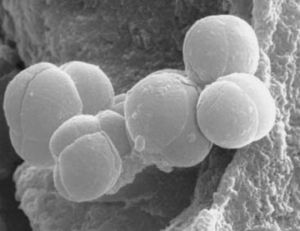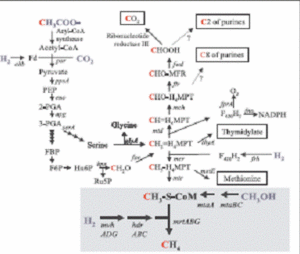Methanosphaera: Difference between revisions
No edit summary |
No edit summary |
||
| (9 intermediate revisions by 2 users not shown) | |||
| Line 1: | Line 1: | ||
{{Curated}} | |||
{{Biorealm Genus}} | |||
[[Methanogens]] overview | |||
[[Image:methanosphaera_stadtmanae.jpg|thumb|300px|right|''Methanosphaera stadtmanae''Image by [http://www.biota.org.br/iScan?54+livros.biota+1+0+archaea+resumo Sérgio Fernando Larizzatti and Vazoller, R. F., BIOTA/FAPESP (The Virtual Institute of Biodiversity).]]] | |||
==Classification== | |||
===Higher order taxa:=== | |||
Archaea; Euryarchaeota; Methanobacteria; Methanobacteriales; Methanobacteriaceae | |||
===Species:=== | |||
''Methanosphaera stadtmanae'' | |||
{| | {| | ||
| height=" | | height="10" bgcolor="#FFDF95" | | ||
'''NCBI: | '''NCBI: [http://www.ncbi.nlm.nih.gov/Taxonomy/Browser/wwwtax.cgi?id=2316 Taxonomy] [http://www.ncbi.nlm.nih.gov/entrez/query.fcgi?db=genome&cmd=Retrieve&dopt=Overview&list_uids=19097 Genome]''' | ||
|} | |} | ||
[[ | |||
==Description and Significance== | |||
''Methanosphaera stadtmanae'' is a Gram-positive, non-motile archaeon that obtains energy for growth by using hydrogen to reduce methanol to methane. This is a unique characteristic for a member of the ''Methanobacteriales'', because it is usually restricted to members of the ''Methanosarcinales''. Also, it is important to note that the archaeon can neither oxidize methanol to CO<font size="-3">2</font> nor reduce CO<font size="-3">2</font> to methane and that it is incapable of growing on CO<font size="-3">2</font>. Instead, it requires both acetate and CO<font size="-3">2</font> as main carbon sources. Further, ''M. stadtmanae'' is the first human archaeal commensal whose genome has been sequenced. | |||
==Genome Structure== | |||
The circular chromosome of ''Methanosphaera stadtmanae'' is 1,767,403 Bp in length. It contains only 1,534 protein-encoding sequences (CDS) and its G + C content is 28%, both of which are the lowest among all methanogens and among all archaeal gemones sequences so far, respectively. Also, it is noteworthy that 30-bp sequence is repeated 59 times in a 4.8 kbp genome segment. The genome of ''M. stadtmanae'' lacks 37 CDS present in the genomes of all other [../methanogens/methanogens.html methanogens], which includes the genetic information for the synthesis of molybdopterin (required for the enzyme catalyzing the first step of methanogenesis from CO<font size="-3">2</font> + H<font size="-3">2</font>) and for carbon monoxide dehydrogenase/acetyl-coenzyme A synthase complex. This explains why the archaeon is unable to reduce CO<font size="-3">2</font> to methane or to oxidize methanol to CO<font size="-3">2</font> and why it requires acetate for growth. | |||
==Cell Structure and Metabolism== | |||
''Methanosphaera'' is spherical-shaped. It produces methane by reducing methanol using methanol and hyrogen only. Also, 95% of the cell carbon is synthesized from acetate and carbon dioxide. Since neither CO<font size="-3">2</font> nor acetate is utilized to produce methane, most of the CO<font size="-3">2</font> or enriched acetate will go into the cell components. This characteristic maximizes the possibility to follow the often unique biosynthetic pathways of [[Methanogens]]. Also, it appears to be auxotrophic for isoleucine or leucine and for thiamine. | |||
[[Image:image002.gif|thumb|300px|left|Metabolic pathways involved in methanol reduction to methane by ''M. stadtmanae'' Image from [http://jb.asm.org/search.dtl W. F. Fricke et al. "The Genome Sequence of ''Methanosphaera stadtmanae'' Reveals Why This Human Intestinal Archaeon Is Restricted to Methanol and H<font size="-3">2 </font>for Methane Formation and ATP Synthesis" ''J. Bacteriology'', January, 2006, Vol. 188, No. 2, p. 642-658. (Fig. 2)]]] | |||
'''Energy metabolism:''' | |||
CH<font size="-3">3</font>OH + HS-CoM → CH<font size="-3">3</font>-S-CoM + H<font size="-3">2</font>O<br /> (Δ G°' = -27 kJ/mol) | |||
CH<font size="-3">3</font>-S-CoM + HS-CoB → CH<font size="-3">4</font> + CoM-S-S-CoB<br /> (Δ G°' = -30 kJ/mol) | |||
CoM-S-S-CoB + 2e<sup>-</sup> + 2H<sup>+</sup> → HS-CoM + HS-CoB<br /> (Δ G°' = -55 kJ/mol) | |||
H<font size="-3">2</font> → 2e<sup>-</sup> + 2H<sup>+</sup><br /> (Δ G°' = 0 kJ/mol) | |||
ADP + P<font size="-3">i</font> → ATP + H<font size="-3">2</font>O<br /> (Δ G°' = -32 kJ/mol) | |||
==Ecology== | |||
The archaeon is known to live in human large intestine. It is responsible for production of methane gas by humans. | |||
==References== | |||
[http://www.ncbi.nlm.nih.gov/entrez/query.fcgi?cmd=Retrieve&db=PubMed&list_uids=3994486&dopt=Abstract Miller TL and Wolin MJ. "''Methanosphaera stadtmaniae'' gen. nov., sp.: a species that forms methane by reducing methanol with hydrogen." ''Archieves of Microbiology'', March, 1985. 141(2): 116-122.] | |||
[http://www.ncbi.nlm.nih.gov/entrez/query.fcgi?cmd=Retrieve&db=PubMed&list_uids=9050163&dopt=Abstract Shelton Bank, Bin Yan, and Terry L. Miller. "Solid C CPMAS NMR spectroscopy studies of biosynthesis in whole cells of ''Methanosphaera stadtmanae''" ''Solid State Nuclear Magnetic Resonance'' 7 (1996) 253-261.] | |||
[http://jb.asm.org/search.dtl Wolfgang F. Fricke, Henning Seedorf, Anke Henne, Markus Kruer, Heiko Liesegang, Reiner Hedderich, Gerhard Gottschalk, and Rudolf K. Thauer. "The Genome Sequence of ''Methanosphaera stadtmanae'' Reveals Why This Human Intestinal Archaeon Is Restricted to Methanol and H<font size="-3">2 </font>for Methane Formation and ATP Synthesis" ''Journal of Bacteriology'', January, 2006, Vol. 188, No. 2, p. 642-658.] | |||
[http://www.biota.org.br/iRead?57+livros.biota+94 Vazoller, R.F.; Manfio, G.P., and Canhos, V.P. "Diversidade no Domínio Archaea." In Canhos, V.P. and Vazoller, R.F. (eds), ''Microrganismos & Virus, Volum 1 Serie Biodiversidade do Estado de São Paulo: ''síntese do conhecimento ao final do século XX Org. by Joly, C.A. and Bicudo, C.E.M., Editora WinnerGraph & FAPESP, São Paulo, (1999) p. 118.] | |||
Latest revision as of 21:13, 6 August 2010
A Microbial Biorealm page on the genus Methanosphaera
Methanogens overview

Classification
Higher order taxa:
Archaea; Euryarchaeota; Methanobacteria; Methanobacteriales; Methanobacteriaceae
Species:
Methanosphaera stadtmanae
Description and Significance
Methanosphaera stadtmanae is a Gram-positive, non-motile archaeon that obtains energy for growth by using hydrogen to reduce methanol to methane. This is a unique characteristic for a member of the Methanobacteriales, because it is usually restricted to members of the Methanosarcinales. Also, it is important to note that the archaeon can neither oxidize methanol to CO2 nor reduce CO2 to methane and that it is incapable of growing on CO2. Instead, it requires both acetate and CO2 as main carbon sources. Further, M. stadtmanae is the first human archaeal commensal whose genome has been sequenced.
Genome Structure
The circular chromosome of Methanosphaera stadtmanae is 1,767,403 Bp in length. It contains only 1,534 protein-encoding sequences (CDS) and its G + C content is 28%, both of which are the lowest among all methanogens and among all archaeal gemones sequences so far, respectively. Also, it is noteworthy that 30-bp sequence is repeated 59 times in a 4.8 kbp genome segment. The genome of M. stadtmanae lacks 37 CDS present in the genomes of all other [../methanogens/methanogens.html methanogens], which includes the genetic information for the synthesis of molybdopterin (required for the enzyme catalyzing the first step of methanogenesis from CO2 + H2) and for carbon monoxide dehydrogenase/acetyl-coenzyme A synthase complex. This explains why the archaeon is unable to reduce CO2 to methane or to oxidize methanol to CO2 and why it requires acetate for growth.
Cell Structure and Metabolism
Methanosphaera is spherical-shaped. It produces methane by reducing methanol using methanol and hyrogen only. Also, 95% of the cell carbon is synthesized from acetate and carbon dioxide. Since neither CO2 nor acetate is utilized to produce methane, most of the CO2 or enriched acetate will go into the cell components. This characteristic maximizes the possibility to follow the often unique biosynthetic pathways of Methanogens. Also, it appears to be auxotrophic for isoleucine or leucine and for thiamine.

Energy metabolism:
CH3OH + HS-CoM → CH3-S-CoM + H2O
(Δ G°' = -27 kJ/mol)
CH3-S-CoM + HS-CoB → CH4 + CoM-S-S-CoB
(Δ G°' = -30 kJ/mol)
CoM-S-S-CoB + 2e- + 2H+ → HS-CoM + HS-CoB
(Δ G°' = -55 kJ/mol)
H2 → 2e- + 2H+
(Δ G°' = 0 kJ/mol)
ADP + Pi → ATP + H2O
(Δ G°' = -32 kJ/mol)
Ecology
The archaeon is known to live in human large intestine. It is responsible for production of methane gas by humans.
